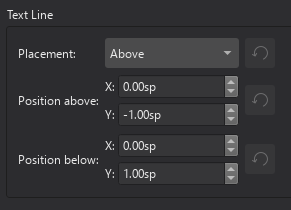Other lines
Overview
Musescore Line is a type of object capable of attaching (anchoring) to a horizontal continuous range of more than two notes or rests, or vertical collection of notes (chord). A Musescore Line object contains a length of string or arc, and optionally a text. These objects can functionally affect the score, and share similar configurable line properties, text properties, and styles.
Musescore Line objects include these subtypes, follow the hyperlink on text to read their dedicated main chapters, or "jump to section" on this chapter:
- Standard line or Plain line (a simple general purpose, straight line) (jump to section)
- Slurs
- Staff text lines and System text lines (jump to section)
- Hairpins and crescendo, decrescendo lines
- Tempo lines such as rit --- (jump to section)
- Voltas (repeat section brackets on top)
- Idiomatic notation: Keyboard: Pedal markings
- Octave lines (8ve etc)
- (Long) Trill lines (jump to section)
- Arpeggios
- Glissandi (slides) and portamento between two notes
- Upprall, Downprall, Prallprall, affects playback
- Guitar-related lines (jump to section): including Barre line, "let ring" line, P.M. --- (palm mute), Vibrato line, and the custom Fingering/String number-line.
- vibrato sawtooth, tremolo sawtooth, does not affect playback
- Ambitus (an early music feature)
These markings contain length of string or arc, but do not belong to Musescore Line objects because they cannot attach (anchor) to a continuous range:
- Bends (brass or guitar articulations)
- Ties
- Tremolo and rolls
- Single note Ornaments such as turns, (short) trills and mordents
- (Staff) Brackets and curly braces
- Barlines
- Staff line (To change global staff line thickness, see Page layout concepts: Staff. Other related settings see Staff/Part properties chapter.)
Note: The following description of actions and general behaviors applies to Line objects discussed here (those do not have a dedicated handbook chapter), for Line objects having dedicated handbook chapters, refer to those chapters for more accurate info.
Adding a line to your score
The commonest way to add a new Musescore Line is to use either:
- a predefined keyboard shortcut, for example S to add slurs (see the respective chapter above), or
- the Lines palette and the Guitar palette
To apply a line to a selected range:
- Select a range of notes,
- Click on a line in a palette;
Or
- Drag a line from a palette to the starting note,
- Adjust the end handle to extend the range (see Changing range of a line).
To apply a line to a single note:
- Select a note and click on the desired palette line.
- Drag a palette line to the desired start note.
Adjusting a line
To adjust the range of a line, see Changing range of a line.
Types of lines
Standard lines
Plain lines are applied from the Lines palette. They can be purposed to anything you like such as to create guitar fingering/string number lines. They can be adjusted to be diagonal or vertical.
Staff and System Text lines
A staff text line, like staff text, is affixed to one staff in a system, and is indicative only for that staff. It appears only in the part featuring that staff.
A system text line, like system text, is affixed to one staff but is indicative for all the staffs in the system. It appears in all instrument parts.
Tempo lines
Tempo markings such as rit --- are new in Musescore 4, they affect playback tempo.
Guitar-related lines
- Barre lines in Guitar palette: Used to indicate fret positions, see Guitar techniques: Adding a barre line to your score.
- To create a Fingering/String number-line:
- add a Fingering from Fingerings palette,
- add a Standard lines from Lines palette,
- adjust the length as required.
- Vibrato in the Guitar palette. You can change the shape of the line in the Vibrato section of the Properties panel.
- Palm mute in the Guitar palette: Changes playback sound to that of a clean muted electric guitar.
- Let ring in the Guitar palette: Affect playback, acts like the sustain pedal on a keyboard.
Trill lines
Not to be confused with (short) trills Ornaments.
Trill lines are upgraded in Musescore 4, their have lots of new engraving settings such as showing a bracketed small note and accidentals to notate trill note pitch, these settings are explained in Ornaments.
They still create playback with SoundFonts instruments like in previous Musescore versions. If the instrument use Muse Sounds and the sound sample exists, a trill line will utilize the beautifully recorded trill audio for playback, for example in case of a perfect fifth trill line.
Line properties
The Properties panel allows you to view and edit General, Appearance, and Playback settings.
The name of the section below varies depending on the type of line. But it will have two tabs marked Style and Text:
Style tab
Clicking on the Style tab allows you to set the properties of the line itself:
Line type: A choice of straight, hooked, angle-hooked, or double-hooked.
Thickness / Hook height:
Style: Choice of solid, dashed or dotted line.
Dash / Gap: Adjust the appearance if "Dashed" is selected.
Text tab
Clicking on the Text tab allows you to apply and position any text associated with the line:
Beginning text: Enter the text, if any, to appear at the beginning of the line.
Vertical offset: Allows you to move the text vertically in relation to the line (in sp.).
Text when continuing to a new system: If the line spans a system, this is the text that will appear before the line in the next system.
Vertical offset: As above.
Line style
Values of the "Style for Text line" can be edited in Format→Style→Text line.
Values of the "Style for System text line" can be edited in Format→Style→System text line.
Values of the "Style for text inside Text line" can be edited in Format→Style→Text styles→Text line
